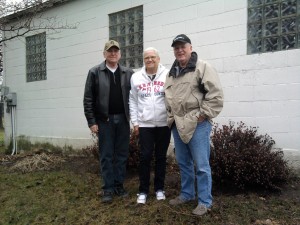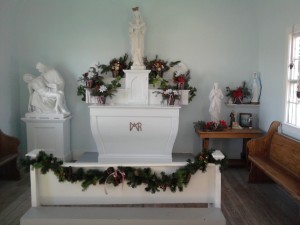Johnsburg’s: A Tale Of Two Chapels
Gregory Harutunian — August 9, 2015
In a photo dated from 2013, (from left) John Huemann, Karen McEvoy, and Mike McEvoy stand by a side wall of the Schmitt chapel on Chapel Hill Road in Johnsburg. Huemann, also a village trustee, and McEvoy, care for the structure, which dates back to the 1840s. Photo by Greg Harutunian
There are two quiet sentinels at opposite ends of Johnsburg that gave Chapel Hill Road its name, and extend back to the 1840s with the original German populations that immigrated to the area.
Creating settlements and farmsteads, descendants of Frederick Schmitt and Mary Miller, who erected the chapels, still live in areas of Lake and McHenry counties.
While possibly taken for granted in the modern era, this tale of two chapels is still notable today as focal points of worship, gathering, and growth for what evolved into the municipal incorporations of Sunnyside, and eventually, Johnsburg.
The Schmitt Chapel
In 1843, Frederick Schmitt and his family were traveling to America by ship, when a violent storm arose. Schmitt prayed to the Virgin Mary for safe passage, and in return, he would build a chapel in her honor. The group arrived safely, and true to his word, a log cabin chapel was built on a site near 2500 N. Chapel Hill Road.
A decade later, it was replaced with a stone building, and the interior is remarkably still authentic to the period of its construction.
“The glass cube blocks in the window cuts, and the outdoor shielding were added sometime in the 1960s, when the golf course was being played heavily,” said John Huemann, a Schmitt descendant and Johnsburg village trustee.

Still reflecting the original appearance and charm, from the 1840s, the Schmitt chapel is one of two chapels in the Johnsburg area dedicated to the Virgin Mary. Descendants from the Schmitt family care for its maintenance today. Photo by Greg Harutunian
The Chapel Hill golf course is directly behind and separates the building with a chain link fence. The golf course was originally the Schmitt farm, and their homestead is extant on the property.
“The first German settlers came here in 1841, and when you think about it, that’s quite amazing,” Huemann said.
Huemann met with Mike McEvoy and his wife, Karen “Cookie” McEvoy at the site, on a drizzly day several weeks ago. Huemann also brought a 65-page list of Schmitt family descendants living in the Spring Grove, Richmond, Volo, Johnsburg, and McHenry areas, compiled by local genealogist Joseph Metzger.
“I married into the family, and I’ve been one of the caretakers for the chapel over the last 10 years,” said McEvoy. “It’s kind of a private project to keep up. The biggest challenge is access and needed maintenance because the chapel is owned by the golf course, and they’re currently in receivership. This creates a legal hurdle to perform those duties.”
An illuminated cross was added to the chapel’s pinnacle by the course owners, and an electrical short circuit sparked a fire in 2006, damaging the roof, during a snowstorm.
“We were lucky the fire department responded so quickly, but the roof had a tarp over it for a couple years,” said Karen McEvoy.
The chapel has yet to be designated as a historical landmark, according to Sean Foley, the special projects manager for the McHenry County Department of Planning and Development.
“There is a process for designation as a historical landmark, which begins with having it nominated, and researched for its historical integrity, and that could have been compromised by renovations,” said Foley.
“It’s also done in conjunction with the owner’s wishes because the status means any work must be in accordance with keeping the integrity. The jurisdictional matters also may necessitate intergovernmental agreements. There is a list of more than 90 sites that have been nominated for that status but haven’t been unable to pass muster for one reason, or another.”
The chapel has seen its service as a place of worship, and communal social point, still serving needs in roundabout ways such as when the statue of the Virgin Mary was stolen from the altar head.
“Another descendant, 90-year old Mary Wagner, told us about it, and my wife and I were going to Fatima on a pilgrimage to view the holy sites in 2006. We saw a statue to replace it, had it blessed there,” said Foley.
“A friend with terminal cancer, Jim O’Brien, asked if he could see it, and I told him Fatima is coming to you. He had it by his bedside for a day, visiting. Not long after, I was in the chapel, when a beam of light came and shined brightly through the windows. I immediately called his wife, and she said he had just passed away. I told her I was aware of it, as he came to say goodbye.”
The future is uncertain for the structure, as all things are.
“We hope to continue its life, and keep the tradition,” said Huemann
Huemann also noted that a Facebook page is online at “Friends of the Chapel Hill Chapel,” as of 2010.
— Johnsburg’s: A Tale Of Two Chapels —







